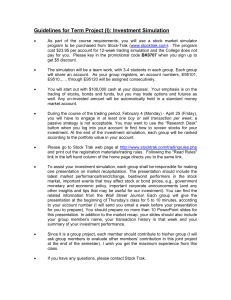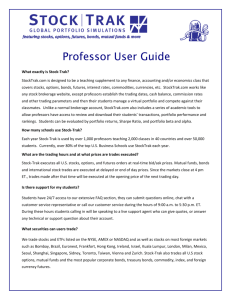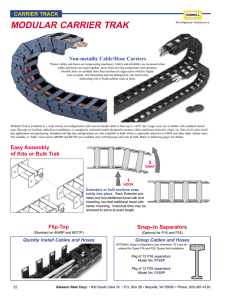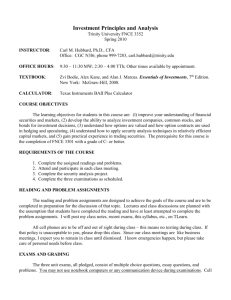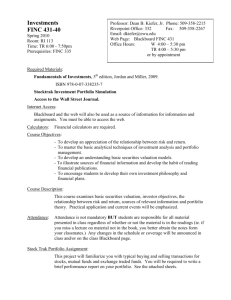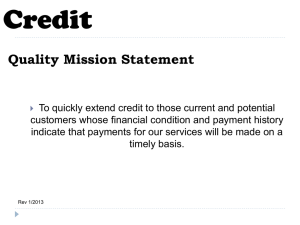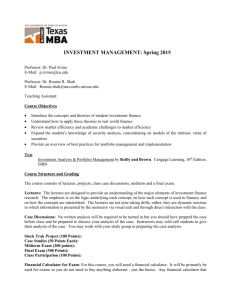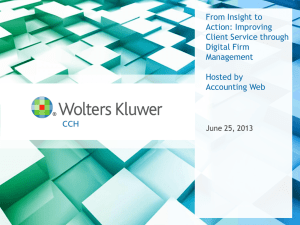MGMT 571-001 (Iyer) - Anderson School of Management
advertisement
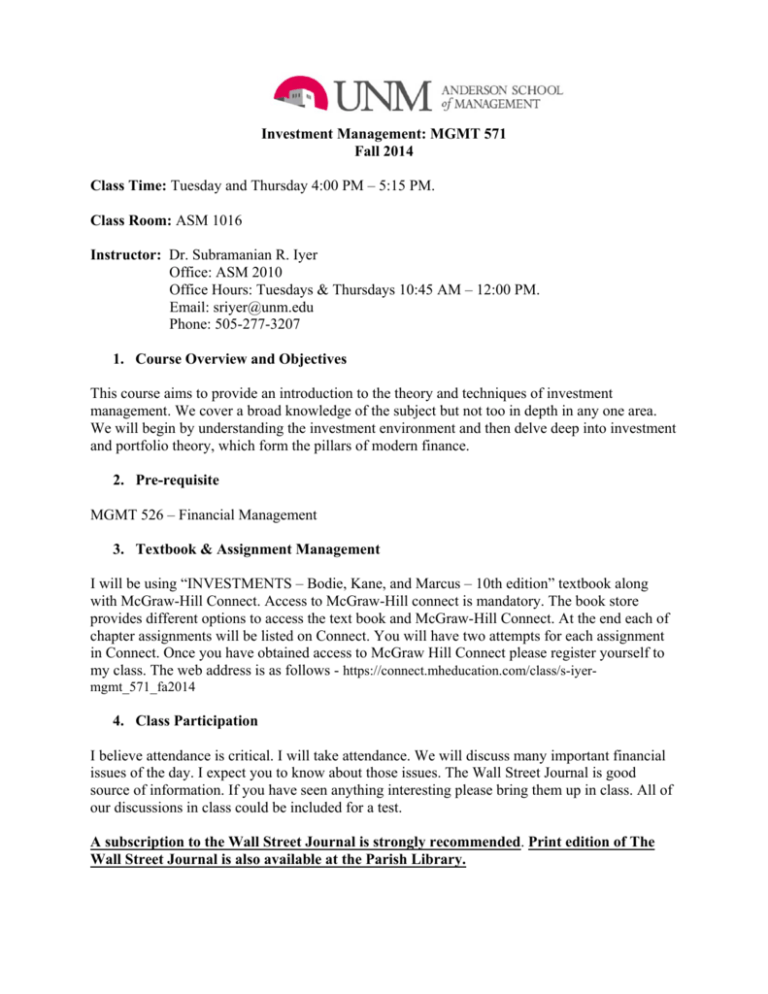
Investment Management: MGMT 571 Fall 2014 Class Time: Tuesday and Thursday 4:00 PM – 5:15 PM. Class Room: ASM 1016 Instructor: Dr. Subramanian R. Iyer Office: ASM 2010 Office Hours: Tuesdays & Thursdays 10:45 AM – 12:00 PM. Email: sriyer@unm.edu Phone: 505-277-3207 1. Course Overview and Objectives This course aims to provide an introduction to the theory and techniques of investment management. We cover a broad knowledge of the subject but not too in depth in any one area. We will begin by understanding the investment environment and then delve deep into investment and portfolio theory, which form the pillars of modern finance. 2. Pre-requisite MGMT 526 – Financial Management 3. Textbook & Assignment Management I will be using “INVESTMENTS – Bodie, Kane, and Marcus – 10th edition” textbook along with McGraw-Hill Connect. Access to McGraw-Hill connect is mandatory. The book store provides different options to access the text book and McGraw-Hill Connect. At the end each of chapter assignments will be listed on Connect. You will have two attempts for each assignment in Connect. Once you have obtained access to McGraw Hill Connect please register yourself to my class. The web address is as follows - https://connect.mheducation.com/class/s-iyermgmt_571_fa2014 4. Class Participation I believe attendance is critical. I will take attendance. We will discuss many important financial issues of the day. I expect you to know about those issues. The Wall Street Journal is good source of information. If you have seen anything interesting please bring them up in class. All of our discussions in class could be included for a test. A subscription to the Wall Street Journal is strongly recommended. Print edition of The Wall Street Journal is also available at the Parish Library. 5. Stock Trak – Simulation Project Stock Trak is a global portfolio simulation tool that works like any other stock brokerage platform. Stock Trak allows virtual trading in stocks, bonds, mutual funds, options, futures, and so on. You have cash of $1,000,000. You should use the $1,000,000 to invest in mutual funds, stocks, bonds, and derivatives (futures and options). Guidelines are attached as a supplement. 6. Exams There will be a midterm and a final exam. Dates for the midterm exam will be announced at least two weeks in advance. Midterm Exam – TBA Final Exam – 12/09/2014 5:30 PM – 7:30 PM Please do not request a different time for the final exam. Since you know the time please do not schedule any other events on during that time. 7. Grading Points for each item are as follows Midterm Exam Final Exam Connect Based Assignments Class Participation Includes attendance and class involvement Stock Trak 200 points 200 points 200 points 200 points 200 points Your grades for the Stock Trak Project will based on the following – Final Report & Presentation 50 points max 3 Monthly reports 3×30 points max Your relative standing in class 60 points max o Meet Expectations 60 points o Positive and place second in class +5 bonus points o Positive and place first in class +10 bonus points Letter grades are assigned using the above scheme and the following cut-off points: The cutoffs for final course letter grades are: 90-100%….………...A 80-89%……………..B 70-79%……………..C 60-69%....…………..D < 59%..……………..F I will consider rounding up the final average for those close to the cutoff for the next higher grade, in which the decision will be based on the trend in the student’s grades throughout the semester, the clustering of student averages, and my assessment of the overall effort of the student. 8. Extra Credit There isn’t any. 9. Students with Special Needs If you are a qualified person with disabilities needing appropriate accommodation, please get in touch with me at the beginning of the semester. Alternatively, you may also contact the Student Accessibility Center. 10. Academic Dishonesty “I hope I shall possess firmness and virtue enough to maintain what I consider the most enviable of all titles, the character of an honest man.” – George Washington (1732 – 1799), First President of the United States of America Anderson School of Management faculty, staff and students commit to values of trust, honesty, integrity, and accountability. We will not tolerate academic dishonesty. By enrolling in any course at Anderson, the student accepts the Anderson Academic Honesty Code and affirms the following pledge: I will not lie, cheat, fabricate, plagiarize or use any other dishonest means to gain unfair academic advantage. Any violation of the code of conduct will be taken very seriously and appropriate sanctions will be applied. FOR FULL TEXT OF ANDERSON’S ACADEMIC HONESTY CODE, please visit http://www.mgt.unm.edu/honesty 11. Classroom Etiquette Be considerate of your classmates and your instructor. All discourse with your fellow students and the instructor must be respectful and civil. Disruptive students will be asked to leave class. There is no eating in class, though soft drinks (please open the bottles or cans before class starts), or coffee, are allowed. Do not place your foot on the chair or table next to you. It is utterly disrespectful. There is no laptop, i-pad or other hand-held electronic device use in class. Turn off your cell phones before class begins and leave them off. This also means no text messaging during class. Violation will result in dismissal for that class period. If you leave class to talk on your cell phone, or leave for any other reason without permission, you are not allowed to return to class. You should not be talking amongst yourselves during class unless it is short-lived and it pertains to class material. Show up to class on time. I believe that punctuality is essential. Please do not disrupt the class rhythm by showing up late. If you leave the class without informing me in advance with a genuine reason, you will lose attendance credit for that session. Requests for consistent late arrival (early departure) to (from) class due to any reason will not be entertained. 12. Tentative List of Chapters Chapter # Chapter Name Plan Week Part I - Introduction 1 2 3 4 Investment Environment Asset Classes and Financial Instruments How Securities are Traded Mutual Fund and Other Investment Companies Lecture Lecture Lecture Lecture/Stok Trak 1 1 2 2 Part II - Security Analysis 17 Macroeconomic and Industry Analysis 19 Financial Statement Analysis 18 Equity Valuation Models Technical Analysis Lecture/Stok Trak Lecture/Stok Trak Lecture/Stok Trak Lecture/Stok Trak 3 3 4 5 Part III - Fixed Income Securities 14 Bond Prices and Yields 15 Term Structure of Interest Rates Lecture/Excel/Stok Trak Lecture/Excel/Stok Trak 5 6 Part IV - Options and Futures 20 Option Markets Introduction 21 Option Valuation 22 Futures Markets 5 6 7 9 Part V- Portfolio Theory Introduction to Risk, Return and the Historical Record Risk Aversion, and Capital Allocation to Risky Assets Optimal Risky Portfolios CAPM Lecture/Excel/Stok Trak Lecture/Excel/Stok Trak Lecture/Excel/Stok Trak Lecture/Stok Trak Lecture/Stok Trak Lecture/Stok Trak Lecture/Stok Trak 7 8 9 10 10 11 11 10 8 11 12 APT Single Index Models Efficient Market Hypothesis Behavioral Finance and Technical Analysis 13 Construct Efficient Portfolios using excel Lecture/Stok Trak Lecture/Stok Trak Lecture/Stok Trak Lecture/Stok Trak Lecture/Excel/Stok Trak 12 13 14 15 16 Stock Trak Simulation Project The goal of this project is to apply the material we learn in class to the real world. The real world is challenging and mistakes will be costly. Simulation is an effective way to learn and turn even the mistakes into a learning opportunity. Stock Trak www.stocktrak.com offers a global portfolio simulation tools that will enable students to achieve the above mentioned objective. The goal of a successful investment strategy is to obtain the maximum return with minimum risk. How well you develop your investment strategy, using concepts will have a profound impact on your grade. Hence, a thorough knowledge of current events in the global economy will be essential to shape your view on deciding the relative attractiveness of various investments, strategies, and markets. To this effect the following are the guidelines of the simulation project – Broad Expectations 1. Pick at least 10 mutual funds a. Out of the 10 mutual funds at least 5 should be stock-based mutual funds 2. Pick at least 20 stocks a. You should choose at least 10 different industries 3. Pick at least 10 bonds – diversify 4. Pick at least 10 option contracts – diversify 5. Pick at least 10 futures contracts – diversify Other information 6. This is a team project and I will announce the teams in class. 7. Please visit the following webpage for details regarding registration http://www.stocktrak.com/public/members/registrationstudents.aspx?p=UNM-Fa14MGMT571. 8. You will have a maximum of 200 trades 9. The endowment is worth $1,000,000. 10. I am always available by email or in person during my office hours or any other time in my office. Please reach out if you any questions. 11. There will be transaction costs. 12. Keep a log of all the trades you conduct. The rationale behind every trade will have to be explained. 13. You can buy assets from any market. For example, if you choose to buy assets from Japan you need to explain your rationale in a comprehensive manner. 14. Limit your exposure to $250,000 for any one asset class. You should diversify. 15. Cost of investment in any single security should not be more than roughly 5% of your initial endowment. Deliverables Expectations 1. There are three monthly reports and a final report. Due dates (subject to change) are – a. Monthly Report 1 – Sep 4, 2014 b. Monthly Report 2 – Oct 2, 2014 c. Monthly Report 3 – Nov 4, 2014 d. Final Report and Presentation – December 4, 2014 2. Monthly Report 1 should contain – a. A preliminary evaluation of the macroeconomic environment i. US unemployment ii. US GDP projections iii. US inflation iv. US consumer spending v. US home sales and home prices vi. FED statements and the credit markets outlook vii. Company earnings and future outlooks viii. Geopolitical environment b. Your investment philosophy – investment objectives such as achieve diversification (of asset classes, industries, countries), a particular asset allocation (25% debt, 45 % equity, and so on), generate return with appropriate risk, beat the S&P 500 benchmark by x%, and so on. Your investment philosophy should be derived from the macroeconomic outlook that you formed by reading and evaluating various reports. 3. Monthly Report 2 and 3 should contain the following a. Macroeconomic outlook – refer the bullet points in Monthly report 1 and present the overall impact of your outlook on each sector – equity and bonds. b. Microeconomic outlook – between the Monthly Report 1 and Monthly Report 2 I expect that you have made some trades. Present a brief evaluation of the news items that influence each of your holding. For example, if you have purchased stocks such as IBM and Netflix. Furthermore, if you have a small-cap stock mutual fund, then present an evaluation of any other news items that might impact the performance of small-cap stocks. c. Performance of your portfolio i. Overall losses/gains ii. Subdivide the overall gains/losses by each sector such as stocks, mutual funds, bonds, futures, and options. iii. Within each sector present each holding and present the gains/losses. iv. I have a penchant for charts and graphs. A picture is worth at least a thousand words. 4. The Final Report – The final report should meet the following expectations. Your grade on this project will depend on your commitment and quality of your work. a. There is no page limit on the final report. b. Reiterate your investment philosophy. Have you made any adjustments? c. Provide a section at the beginning stating the project expectations and how you met them. If there are any deviations state them clearly. d. Performance of your portfolio – refer monthly report 2 and 3. e. Provide a description of the technique you employed for buy/sell. For example, for stocks explain whether you used fundamental analysis (what attribute of the stock(s) you used) or technical analysis (specific indicators) to buy/sell. Modify appropriately for other asset categories. f. List the number of industries in your overall portfolio. Include a brief future outlook for the industry. g. If you chose to diversify outside the US - for each country in your portfolio include the current and future outlook with exchange rate fluctuations. You may choose to put all your money in the US stock market, in that I don’t expect any report on exchange rate fluctuations h. For bonds, I expect an outlook on the future exchange rates and the bonds that you hold in your portfolio. i. For mutual funds, describe the investment style, performance against appropriate benchmarks (www.ishares.com) will be a good source for benchmarks) j. Which positions exceeded your expectations? k. Which positions underperformed for you? l. What are the key take aways from your Stock-Trak experience? m. How will your Stock-Trak experience influence your personal investing in the future? n. Any suggestions to improve the Stock-Trak experience for future students.
